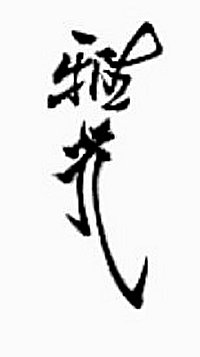| |
MASAMITSU
|
|
| |
||
Artist ¨C MASAMITSU
Ōta also known as
Ōta Gako (Ì«Ìï ÑŹâ, 1892¨C1975) was a Japanese print-maker. He was
one of the masters of the shin hanga movement. His work
consisted mostly of kabuki actor prints that emphasized the
individual personality of the actors, showcased through rich
colors and exquisite patterns of complex design.
Ōta had a lifelong involvement with kabuki theater. Well known is his 1924 series "Kabuki Kumadori" about kabuki makeups. "Kumadori" is a distinctive type of kabuki makeup used for aragoto characters. Aragoto refers to an exaggerated style of acting used to depict heroic warriors, demons, or fierce gods. The bombastic style encompasses all elements of the role, including hair, makeup, dialogue, and costume. These striking designs depict bold and colorful makeup, often giving the characters a frightening or otherworldly appearance. In 1931, he illustrated a book about 18 kabuki plays (Kabuki juhachiban).
A leading kabuki artist of the later shin hanga period, MASAMITSU Ōta is best known for his two, 12 print portrait series, "Figures of the Showa Stage" (Showa Butai Sugata, 1950) and "Leading Figures of the Modern Stage in their Most Famous Roles" (Gendai Butai Geika, 1955) both series published by Banchoro. In 1966, he provided illustrations for "Kabuki Costume", a book by Ruth Shaver.
In Ōta¡¯s works, we see the evolution of the shin hanga actor print towards more realistic portraiture. His designs incorporate Western style shading and perspective to create a much more three-dimensional image, along with beautifully precise line work and saturated color, achieved through the use of western techniques of perspective and through beautiful shading (bokashi) and attention to detail.
MASAMITSU Ōta's kabuki portraits are comparable to those of the better known Natori Shunsen, but Ōta's work remains little known and his woodblocks are rarely seen. His actor portraits are a somehow interesting mixture of the 3-dimensional shadings and the large flat areas of Japanese traditional kabuki prints. The characteristics of individual actors were also presented in the finely detailed depictions of faces and hands. His powerful and expressive portraits capture the individual personality of the performer.
He is thought to have had a brief one-print collaboration with the publisher Watanabe in 1945. For whatever reason, this relationship did not last. Beginning with the early 1950's, Ota worked with the publisher Banchoro. He did not begin designing kabuki woodblock prints until after WWII.
Personal life - so far no information available
Aliases - MASAMITSU Ōta also known as Ōta Gako (Ì«Ìï ÑŹâ)
Disciples - none known
Ōta had a lifelong involvement with kabuki theater. Well known is his 1924 series "Kabuki Kumadori" about kabuki makeups. "Kumadori" is a distinctive type of kabuki makeup used for aragoto characters. Aragoto refers to an exaggerated style of acting used to depict heroic warriors, demons, or fierce gods. The bombastic style encompasses all elements of the role, including hair, makeup, dialogue, and costume. These striking designs depict bold and colorful makeup, often giving the characters a frightening or otherworldly appearance. In 1931, he illustrated a book about 18 kabuki plays (Kabuki juhachiban).
A leading kabuki artist of the later shin hanga period, MASAMITSU Ōta is best known for his two, 12 print portrait series, "Figures of the Showa Stage" (Showa Butai Sugata, 1950) and "Leading Figures of the Modern Stage in their Most Famous Roles" (Gendai Butai Geika, 1955) both series published by Banchoro. In 1966, he provided illustrations for "Kabuki Costume", a book by Ruth Shaver.
In Ōta¡¯s works, we see the evolution of the shin hanga actor print towards more realistic portraiture. His designs incorporate Western style shading and perspective to create a much more three-dimensional image, along with beautifully precise line work and saturated color, achieved through the use of western techniques of perspective and through beautiful shading (bokashi) and attention to detail.
MASAMITSU Ōta's kabuki portraits are comparable to those of the better known Natori Shunsen, but Ōta's work remains little known and his woodblocks are rarely seen. His actor portraits are a somehow interesting mixture of the 3-dimensional shadings and the large flat areas of Japanese traditional kabuki prints. The characteristics of individual actors were also presented in the finely detailed depictions of faces and hands. His powerful and expressive portraits capture the individual personality of the performer.
He is thought to have had a brief one-print collaboration with the publisher Watanabe in 1945. For whatever reason, this relationship did not last. Beginning with the early 1950's, Ota worked with the publisher Banchoro. He did not begin designing kabuki woodblock prints until after WWII.
Personal life - so far no information available
Aliases - MASAMITSU Ōta also known as Ōta Gako (Ì«Ìï ÑŹâ)
Disciples - none known
Copyright 2008 ff: Hans P. Boehme
